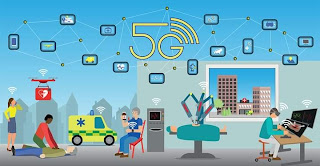In the regions of the world where people are benefiting from 5G network, new innovations and communication facilities have come to their health sector. Here are 7 uses of 5G networks that are shaping the future of healthcare.
1. Connected Ambulance
Experts believe that the “connected ambulance” system will make it easier for patients to access emergency services and increase the chances of patients receiving better treatment.
A connected ambulance and the health workers on board can constantly send real-time patient data to the hospital.
Wearables, sensors, or live streaming (HD video or body cameras) will be used to collect data. This will allow the doctors in the hospital to prepare the patient in advance, which will save valuable time.
2. High Definition Virtual Consultation
Establishing two-way HD video communication between patient and doctor for basic examinations, routine check-ups (where physically absent), therapy, rehabilitation sessions, etc. Work is becoming possible now. All these works are done even if the patient does not come directly to the doctor. Thus both parties are saving time and money.
3. Monitor Remote Patients
Remote patient monitoring is now recognized as an important task for efficient and responsive healthcare and complex patient management.
The patient’s updated status information is being collected and analyzed using various sensors, wearables and e-health care devices. For this, the patient no longer has to push the jam-traffic and run to the doctor’s chamber.
4. Use Of Cideo In Medication Administration
There are many, especially mentally ill and elderly patients, who often forget their daily medication or take the wrong medication. 5G network can ensure that patients take the right medicine at the right time through video.
For this, trained pharmacists and attendants will connect with the patient on video, and ensure that they are taking the right medicine at the right time.
5. Augmented Reality And Virtual Reality Assistance For The Blind
It is difficult for those of us with eyes to understand how people who are partially or totally blind go about everyday tasks.
Crossing a street, browsing a website, or even entering a building is difficult for them.
Using a 5G-enabled AR/VR headset or video streaming glasses, the visually impaired can instantly connect with a consultant. The consultant will guide him on various issues along the way.
6. Distraction And Rehabilitative Therapy
Augmented reality and virtual reality can be used in hospitals to provide better services to patients. For example, AR/VR can be used in distraction and rehabilitative therapy.
In distraction therapy, when a child is injected, a headset will be worn to distract them. Using 5G, this headset can play videos or applications of the child’s choice so that he forgets about injections.
Again, during rehabilitative therapy or rehabilitation, a person who has lost an arm or a leg, uses augmented reality to implant the missing limb virtually. Many are saved from phantom limb syndrome. Phantom limb syndrome is a condition in which patients experience pain or a painless sensation in a limb that no longer exists.
7. Assisting Expert Doctors Through Video During Surgery
After the advent of 5G, a word that is often heard in the health sector is “telesurgery”. In this system, an expert surgeon can perform the surgery remotely. However, for this, both places need to have 5G network. However, we have to wait for some more time to fully implement this facility.
More realistically, however, are surgeons using 5G AR/VR headsets. This allows them to see what is happening in real time and also guide the person performing the surgery. In this case, experts can make decisions based on their own experience and what they see in front of their eyes.


